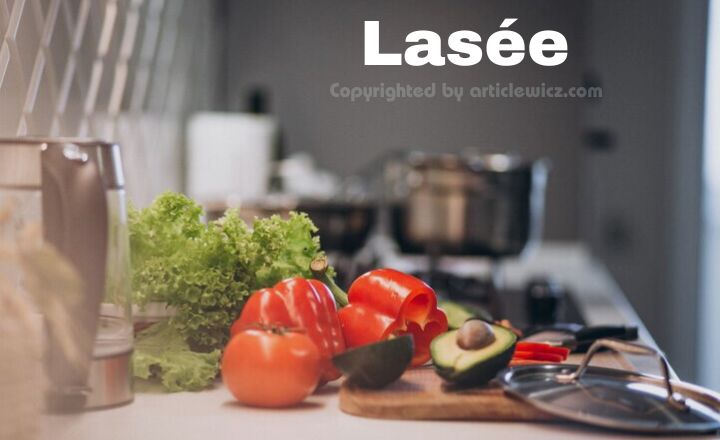Everything About Lasée : A Comprehensive Guide in Depths

Introduction to Lasée
Lasée, a conventional Haitian alcoholic beverage, receives its call from Haitian Creole, which translates to “the squeezed.” This name flawlessly captures the essence of the drink, because it symbolizes the technique of extracting sugarcane juice. This fragrant concoction is a true embodiment of Haitian tradition, mixing the essence of sugarcane with a number of spices like cinnamon, clove, lime, and anise, ensuing in a delightful rum punch that tantalizes the taste buds.
Lasée is not only a drink; it’s a image of social connectivity in Haitian communities. It’s frequently shared amongst pals and circle of relatives for the duration of festive gatherings or leisurely weekends, bringing people together in a spirit of camaraderie and birthday party. With its roots deeply intertwined with Haiti’s colonial history, lasée serves as a testomony to the state’s wealthy historical past, supplying a sensory journey thru time with each sip.

History and Origin
The records of lasée spans centuries, originating in Asia the various Hmong network. This intricate art shape became born from the way of life of hand embroidery, in which every stitch advised a tale of cultural motifs and legacies. When Hmong Americans migrated to the United States, they added this loved art shape with them, keeping their cultural historical past amidst new landscapes.Crafting a unmarried piece of lasée is a labor of love that involves infinite hours of meticulous hand embroidery. Each sew weaves narratives of nature’s bounty, with vibrant motifs depicting birds, butterflies, and celestial bodies. These motifs characterize familial bonds and cultural pride, making lasée extra than just an artwork shape—it is a tapestry of lifestyle that connects generations thru its symbolic language.
Ingredients Used in Lasée
Lasée is made the usage of a variety of ingredients that deliver it its specific taste and texture. The key substances consist of palm oil, tomatoes, onions, garlic, ginger, and a blend of spices. Meat or fish is likewise introduced to the dish, along with veggies like okra or spinach. These substances come collectively to create a flavorful and fragrant dish that is enjoyed throughout African delicacies.
Crafting the Perfect Lasée
Crafting the suitable Lasée, a traditional French custard dessert, is a lovely culinary endeavor that results in a velvety texture and a subtle flavor profile. This dessert calls for only a handful of simple substances and some easy steps:
Ingredients:
- Egg yolks
- Sugar
- Milk or cream
- Vanilla extract (elective)
Instructions:
- Whisk egg yolks and sugar in a heatproof bowl till nicely mixed.
- Heat milk/cream and vanilla (if preferred) in a saucepan till it reaches 170-a hundred seventy five°F, stirring constantly.
- Gradually pour the recent milk into the egg mixture even as whisking constantly.
- Strain the mixture thru a great mesh strainer right into a clean saucepan to make certain a smooth custard.
- Cook the custard over medium-low heat until it thickens, coating the back of a spoon.
- Remove from heat, stirring for 30 seconds to save you curdling.
- Pour the Lasée into serving dishes and sit back before serving.
Health Benefits of Lasée
Lasée, a traditional African dish, offers numerous health benefits because of its nutritious components and cooking strategies. Typically made with meat or fish, Lasée is rich in protein, crucial for muscle construction and repair. The dish also includes substances like tomatoes, onions, garlic, and ginger, imparting quite a few nutrients and minerals critical for usual health.
Additionally, Lasée is cooked with palm oil, which contains healthy fats useful for coronary heart health and cellular feature. The dish’s components also are wealthy in antioxidants, assisting to defend the body against oxidative stress and irritation. Furthermore, Lasée regularly consists of spices like cumin and coriander, which can aid digestion and enhance gut health. Overall, Lasée is a flavorful and nutritious dish that can be a valuable addition to a balanced eating regimen.
Cultural Significance
Lasée holds a profound cultural significance in African and Caribbean communities, serving as a culinary brand of way of life, community, and history. In African societies, Lasée is greater than only a dish; it symbolizes togetherness and harmony, frequently prepared and shared during special occasions and gatherings. The communal aspect of getting ready and enjoying Lasée reinforces familial bonds and creates a experience of belonging.
In Haitian way of life, Lasée’s history displays resilience and resourcefulness, because it originated from the creativity of enslaved Africans. Today, Lasée represents Haitian identification and serves as a reminder of the strength and ingenuity of the Haitian people. Overall, Lasée’s cultural importance lies in its potential to keep and rejoice cultural historical past, bridging the past with the present through its flavorful traditions.
How to Make Lasée at Home

To make lasée at domestic, start through heating palm oil in a pot and sautéing onions, garlic, and ginger till aromatic. Add tomatoes, spices, and your choice of meat or fish, and simmer till cooked via. Serve warm with rice or bread.
Making Lasée at domestic is a simple and rewarding technique. Here’s a fundamental recipe to help you get started out:
Ingredients:
- 2 kilos meat or fish (bird, red meat, or fish fillets)
- 1 cup palm oil
- 2 onions, finely chopped
- 3 tomatoes, chopped
- three cloves garlic, minced
- 1 tablespoon ginger, minced
- 1 teaspoon floor cumin
- 1 teaspoon ground coriander
- Salt and pepper to flavor
- 2 cups water or broth
- Vegetables (optionally available, which include okra or spinach)
Instructions:
- Heat the palm oil in a big pot over medium warmness.
- Add the onions, garlic, and ginger, and sauté till aromatic, about 2-three mins.
- Add the tomatoes, cumin, coriander, salt, and pepper, and cook dinner for every other 5 mins, stirring sometimes.
- Add the beef or fish to the pot and prepare dinner until browned on all aspects, about 5-7 minutes.
- Pour in the water or broth, cover the pot, and simmer for approximately 30 minutes, or until the meat is tender.
- If the usage of greens, upload them to the pot over the past 10 mins of cooking.
- Taste and adjust the seasoning as wanted.
- Serve the Lasée warm over rice or with crusty bread
Popular Lasée Recipes
There are many variations of lasée, relying at the area and personal alternatives. Some popular recipes encompass lasée with hen, lasée with fish, and vegetarian lasée with okra.
Lasée in Modern Cuisine
In modern culinary landscapes, Lasée has undergone a transformation from its traditional origins, emerging as a versatile and progressive dish. Chefs globally have embraced Lasée, infusing it with creative twists and interpretations that push the boundaries of taste and presentation. This evolution sees Lasée not restricted to its authentic shape but alternatively celebrated as a culinary canvas for experimentation.
In upscale eating institutions, Lasée is elevated to gourmet repute, with cooks choosing premium elements and employing sophisticated techniques to create a polished and flavorful enjoy. Conversely, in casual eating settings, Lasée has emerge as a liked comfort food, performing in numerous interpretations, from hearty stews to spicy curries, appealing to a various range of palates. Lasée’s ability to conform and captivate in present day delicacies highlights its enduring attraction and its position as a cultural ambassador for African and Caribbean culinary traditions.
Where to Find Lasée?
Finding Lasée outside of Africa can be a bit challenging, but there are some locations where you is probably capable of locate this scrumptious dish. African eating places or markets specializing in African ingredients are your exceptional bet. Cities with large African immigrant populations, together with London, Paris, New York, or Toronto, regularly have restaurants that serve traditional African delicacies, inclusive of Lasée. Additionally, some online retailers may promote pre-made Lasée sauce or seasoning mixes, allowing you to recreate the dish at home. If you are feeling adventurous, you can additionally strive making Lasée from scratch the usage of online recipes and ingredients from your neighborhood grocery save.
Lasée in Popular Culture
Lasée, a traditional African dish, has determined its way into famous subculture, representing more than only a culinary delight. Its presence in literature, movie, and tune displays the deep-rooted cultural significance and delight related to African cuisine. In literature, Lasée serves as a image of cultural identity, frequently used to discover topics of heritage and culture. In visible media, along with film and tv, Lasée is depicted as a colourful and flavorful dish, showcasing the variety of African culinary traditions. Additionally, references to Lasée in tune highlight its rich flavors and cultural significance, in addition solidifying its location in popular lifestyle as a symbol of African historical past and culinary excellence.
Conclusion
In end, Lasée is extra than only a dish or a drink—it is a symbol of cultural delight and history. Whether enjoyed as a savory African stew or sipped as a conventional Haitian rum punch, Lasée represents the wealthy diversity and history of African and Caribbean cultures. Its flavors and aromas tell testimonies of lifestyle, community, and resilience, making it a loved part of culinary and cultural historical past. As you discover the sector of Lasée, you are no longer simply experiencing a meal or a beverage—you are embarking on a adventure thru time and tradition, connecting with the vibrant cultures that have formed these iconic dishes.
Read Must : Ceciir a Culinary and Social Excursion through Turkish Practice
FAQs
Is Lasée highly spiced?
Yes, lasée may be highly spiced depending on the amount of chili powder or other spices used within the recipe.
Can I make Lasée vegetarian?
Yes, you can make a vegetarian version of lasée by way of omitting the meat or fish and adding greater vegetables like okra or spinach.
What does Lasée flavor like?
Lasée has a rich, savory taste with a hint of sweetness from the tomatoes and onions. The spices upload intensity and complexity to the dish.
Is Lasée a healthy dish?
Yes, lasée is a healthy dish as it’s far high in protein, vitamins, and minerals. However, it’s also high in fat due to the palm oil used in cooking.
Can I freeze Lasée?
Yes, you can freeze lasée for later intake. Simply store it in an airtight field and thaw it inside the refrigerator before reheating.




